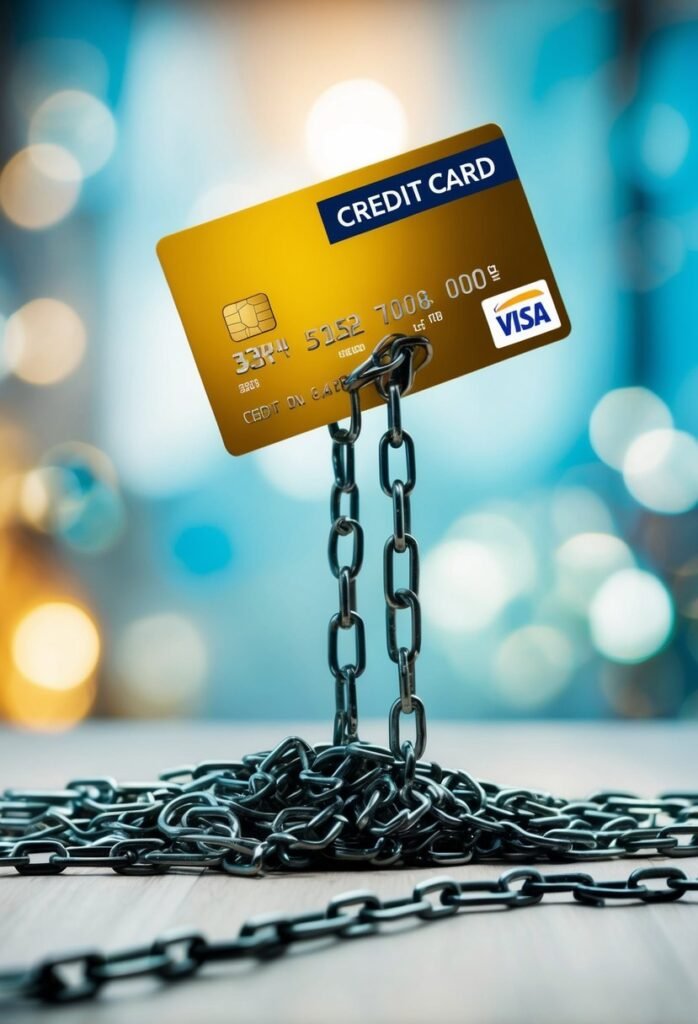Credit cards can feel like a double-edged sword in our financial lives. Many people, myself included, learn early on—perhaps in college—how tempting it is to swipe now and worry later. What often starts as small, manageable purchases can quickly snowball into significant credit card debt that takes years to clear. To maintain financial freedom and avoid the debt trap ensnaring millions, following specific credit card rules is absolutely essential.
Before going further, this is the very advice that has seen two of my colleagues escape the debt trap, having sunk so deep that they were at risk of having their assets repossessed by the sheriff of the court.
Alexander Whaley

The good news? Credit cards don’t have to lead to financial ruin. Used wisely, they are powerful tools for building a positive credit history and even earning valuable rewards. The key lies in consistently applying proven strategies for responsible credit card use. The single most important rule? Always pay your balance in full each month. This prevents costly interest charges that fuel debt accumulation.
My personal breakthrough came from a simple principle: never charge something if you don’t already have the cash to cover it. This one habit has been instrumental in keeping me debt-free. Combined with a realistic spending plan aligned with your financial goals, these practices form the foundation for staying out of credit card debt. These are the foundations for behavioral change, and you need to change your basic behavior towards money. Financial psychologist Dr. Brad Klontz notes that money behaviors are often formed in childhood (Klontz & Klontz, 2021). This aligns with my experience helping readers identify their ‘money scripts’—those unwritten rules we follow without questioning. Though I lack Dr. Klontz’s clinical background, my work with hundreds of readers has revealed common patterns that match his research findings.”
Key Takeaways
- Pay your balance in full monthly to dodge interest and prevent debt growth.
- Only use credit cards for purchases you can afford with existing funds.
- Create and follow a realistic budget that incorporates financial goals for long-term debt prevention.
Understanding Credit Cards and the Risk of Debt

While useful financial tools, credit cards require careful management to prevent serious debt problems. The combination of easy spending and compounding interest makes them particularly risky if not handled with discipline.
Credit Card Basics Explained
Think of a credit card as a pre-approved loan allowing you to make purchases up to a set limit. When you use the card, you’re borrowing money that must be repaid. Ideally, you repay the entire balance each month. Failing to do so results in interest charges on the remaining amount.
Most credit cards have these key features:
- Credit Limit: The maximum amount you can borrow.
- Grace Period: Typically 21-25 days between the statement closing date and the due date, during which no interest accrues if you paid the previous balance in full.
- Minimum Payment: The smallest amount required monthly (often 1-3% of the balance), but paying only this drastically increases total interest paid.
- Annual Fee: Some cards charge a yearly fee for membership.
Credit cards offer convenience, help build credit history, and provide rewards. Problems arise from misunderstanding the terms or using them irresponsibly.
How Credit Cards Contribute to Debt Accumulation
Credit card debt often grows subtly. The ease of swiping makes it dangerously simple to spend beyond your means. Without a clear plan to pay off the balance promptly, debt can spiral.
The revolving nature is a key risk: you can continue spending up to your limit while making only minimum payments, allowing debt (and interest) to grow indefinitely.
Credit Utilization – the ratio of your balance to your credit limit – is crucial. Experts recommend keeping this below 30% (ideally even lower) to maintain a healthy credit score. High utilization signals risk to lenders.
Managing multiple cards also complicates things, making spending harder to track and increasing the total minimum payment burden.
Interest Rates (APR) and Their Role in Expanding Debt
Credit card Annual Percentage Rates (APRs) are typically much higher than other loan types, often ranging from 15% to over 24%. This makes them one of the most expensive ways to borrow.
Interest compounds, meaning you pay interest not only on the principal but also on previously accrued interest. This snowball effect causes debt to grow exponentially, even if you stop making new purchases.
Consider how a $1,000 balance balloons with minimum payments:
| Interest Rate | Time to Pay Off | Total Interest Paid |
|---|---|---|
| 15% APR | ~7 years | ~$800 |
| 20% APR | ~9 years | ~$1,200 |
| 25% APR | ~12 years | ~$1,800 |
Paying only the minimum traps you in debt for years, with most of your payment going towards interest, not the principal balance.
Strategies to Stay Out of Credit Card Debt

In 2011, after reading ‘Your Money or Your Life,’ I implemented the book’s tracking system for three months. While the core concept was valuable, I found the paper-based approach too time-consuming. By January 2014, I had developed the digital adaptation described below, which reduced my tracking time from 5 hours to 45 minutes monthly while maintaining the awareness benefits.
Avoiding credit card debt requires smart planning, disciplined spending, and preparing for the unexpected. These strategies help secure financial freedom.
Effective Debt Management Plans
A solid plan starts with understanding your spending. Track all expenses for a month to identify patterns and areas for potential savings. .
Key components of an effective plan include:
- Create a Realistic Budget: Allocate funds for needs, wants, and savings goals.
- Prioritize On-Time Payments: Late payments incur fees and severely damage your credit score.
- Pay More Than the Minimum: Always aim to pay as much above the minimum as possible, ideally the full balance.
- Choose a Payoff Strategy (if needed):
- Debt Snowball: Pay off smallest debts first for motivation.
- Debt Avalanche: Pay off highest-interest debts first to save money.
- Automate Payments: Set up auto-pay for at least the minimum payment to avoid missed due dates.
- Regularly Review Progress: Monitor your balances and adjust your plan as needed.
Avoiding High-Interest Debt
High APRs accelerate debt growth. To minimize this risk:
- Maintain Low Credit Utilization: Keep balances well below 30% of your credit limits.
- Compare APRs: When choosing cards, look beyond introductory offers to the ongoing APR.
- Negotiate Lower Rates: If you have good payment history, ask your current issuer for a rate reduction.
- Consider Balance Transfers: Transfer high-interest balances to cards with 0% introductory APRs (beware of transfer fees and the post-introductory rate). [Link to internal article on balance transfers, if available].
- Prioritize High-Interest Debt: Use the debt avalanche method to tackle expensive debt first.
- Practice Mindful Spending: Implement a 24-hour waiting period for non-essential purchases to curb impulse buys.
The Importance of an Emergency Fund
An emergency fund is crucial debt prevention. It’s your safety net for unexpected costs (job loss, medical bills, car repairs), preventing reliance on credit cards.
- Start Small: Aim for $1,000 initially.
- Build Gradually: Work towards saving 3-6 months of essential living expenses.
- Automate Savings: Set up regular automatic transfers from checking to a dedicated savings account.
- Keep it Accessible (but Separate): Ensure you can access funds quickly in an emergency, but not so easily you dip into it for non-emergencies.
- Replenish After Use: Prioritize rebuilding the fund after withdrawing from it.
Having an emergency fund is one of the most effective ways to break the cycle of credit card debt.
careful budgeters can fall into debt cycles when surprises occur. Research shows that having an emergency fund is one of the strongest ways to stay out of credit card debt for good.
Best Practices for Responsible Credit Card Use

Using credit cards wisely involves discipline and understanding. These practices help you leverage the benefits while avoiding the pitfalls of debt.
Cultivating Responsible Spending Habits
- Treat Credit Like Cash: Only charge what you can afford to pay off immediately.
- Budget and Track Spending: Know where your money goes and stick to category limits.
- Needs vs. Wants: Prioritize using credit for essential needs rather than discretionary wants if funds are tight.
- Pay in Full, On Time: This is the golden rule of responsible credit card use.
- Set Payment Reminders/Automate: Avoid late fees and credit score damage.
- Review Statements: Check monthly for errors, fraud, or unexpected fees.
- Build an emergency fund to avoid relying on credit cards when you are in a bind.
Understanding Rewards and Cash Back
Credit card rewards (cash back, points, miles) are beneficial only if you avoid interest charges.
- Align Rewards with Spending: Choose cards that reward your existing spending patterns (e.g., gas, groceries). Don’t overspend just to earn rewards.
- Understand the Terms: Check for annual fees, reward caps, expiration dates, and redemption rules in the credit card agreement.
- Consider Sign-Up Bonuses: These can be valuable but often require meeting a minimum spending threshold. Ensure you can meet it through normal spending.
- Don’t Carry a Balance for Rewards: Interest paid will almost always negate the value of rewards earned.
Types of reward programs:
- Cash back (typically 1-5% on purchases)
- Travel points or miles
- Store-specific rewards
- Sign-up bonuses
Maintaining a Healthy Credit Score
Responsible credit card use is key to building and maintaining a good credit score.
- Pay Bills On Time: Payment history is the most significant factor (35% of FICO score).
- Keep Credit Utilization Low: Aim for below 30%, ideally below 10%.
- Check Credit Reports Regularly: Monitor for errors or fraud.
- Maintain Old Accounts: Length of credit history matters (15% of FICO score). Keep long-standing accounts open and occasionally active (if fee-free).
- Apply for New Credit Sparingly: Too many applications in a short period can temporarily lower your score.
A strong credit score provides access to better loan terms and interest rates in the future.
Navigating Credit Reports and Scores
Understanding your credit standing is vital for financial health and avoiding debt traps.
Regular Monitoring of Credit Reports
Check your credit report from each major bureau (Equifax, Experian, TransUnion) at least annually. You can get free copies via AnnualCreditReport.com.
Look for:
- Inaccurate personal information.
- Accounts you don’t recognize (potential identity theft).
- Incorrectly reported late payments or balances.
- Errors related to student loans or other debts.
Dispute any errors promptly with the respective credit bureau, leveraging your rights under the Fair Credit Reporting Act.
How Credit Scores are Calculated
Credit scores (like FICO or VantageScore) summarize your credit risk based on several factors:
- Payment History (35%): Consistency of on-time payments.
- Amounts Owed / Credit Utilization (30%): How much debt you carry relative to your limits.
- Length of Credit History (15%): Average age of your accounts.
- Credit Mix (10%): Diversity of credit types (cards, installment loans).
- New Credit (10%): Recent applications and newly opened accounts.
Frequently Asked Questions
Credit card management requires specific knowledge and disciplined practices. Below are answers to common questions that can help you maintain financial health and avoid the pitfalls of credit card debt.
What are proven strategies for avoiding credit card debt?
I recommend paying your balance in full each month to avoid interest charges. This simple habit can save thousands of dollars over time.
Set up automatic payments to ensure you never miss a due date. Late payments can trigger penalty APRs and fees that quickly compound your debt.
Create spending limits below your credit limit. Just because you have a $5,000 limit doesn’t mean you should use it all. The Fair Debt Collection Practices Act provides protection if you do fall into debt, but prevention is always better.
How does having a co-signer with good credit affect your credit card application?
A co-signer with excellent credit significantly improves your approval chances. Their strong credit history provides the security card issuers look for when evaluating risk.
You’ll likely qualify for better interest rates and higher credit limits with a co-signer. These improved terms can save considerable money over time.
Remember that your co-signer becomes equally responsible for the debt. Any missed payments will damage both your credit scores, potentially harming relationships.
Can you outline the steps necessary to eliminate existing credit card debt?
I suggest starting with the debt avalanche method—paying minimum payments on all cards while putting extra money toward the highest-interest debt first. This minimizes interest paid over time.
Another effective approach is the debt snowball method, where you pay off the smallest balances first to build momentum. Small victories can provide motivation to continue.
For substantial debt, consider debt relief options like consolidation loans or negotiated settlements. These approaches can reduce total payoff amounts and simplify your payment schedule.
What are some smart habits for using a credit card to improve your credit score?
I always maintain a utilization ratio below 30% of my available credit. Lower utilization shows responsible credit management and positively impacts your score.
Make all payments on time, every time. Payment history comprises 35% of your FICO score, making it the most influential factor in credit scoring.
Keep older accounts open even if rarely used. Length of credit history affects 15% of your score, so maintaining long-standing accounts benefits your overall profile.
Why is establishing a budget crucial when utilizing credit cards?
A budget creates clear spending boundaries that prevent impulsive purchases on credit. It helps differentiate between needs and wants before reaching for your card.
I track all credit card spending as part of my budget, treating card purchases as immediate expenses rather than future ones. This mental accounting prevents overspending.
Without a budget, credit card debt can accumulate quickly and become overwhelming before you notice there’s a problem. The average American household carries over $6,000 in credit card debt.
How does the rule of 72 apply to understanding credit card debt accumulation?
The rule of 72 helps calculate how quickly debt doubles. You can find the years it takes for debt to double if left unpaid by dividing 72 by your credit card’s interest rate.
With a typical credit card interest rate of 18%, debt doubles in just 4 years (72 ÷ 18 = 4). This exponential growth explains why small balances become major problems.
I use this rule as motivation to avoid carrying balances. Understanding that $1,000 in debt today could become $2,000 in four years without additional charges makes the cost of credit card debt concrete and compelling.


Your blog is a testament to your dedication to your craft. Your commitment to excellence is evident in every aspect of your writing. Thank you for being such a positive influence in the online community.
Your blog has quickly become my go-to source for reliable information and thought-provoking commentary. I’m constantly recommending it to friends and colleagues. Keep up the excellent work!